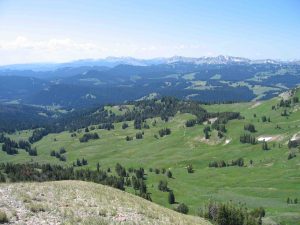EARLIER THIS WEEK, the Wyoming Outdoor Council co-led its second summer field trip to the site of a proposed 136-well gas field in the Hoback Basin, in a relatively untouched part of the Wyoming Range.
We were able to enjoy some of the basin’s most precious resources, including its dazzling vistas and quiet solitude.
The area provides outstanding habitat for mule deer, elk, and moose; creeks important to native cutthroat trout; and a crucial migration corridor for the threatened Canada lynx.
This piece of the Bridger-Teton National Forest is also a favorite spot of Wyoming sportsmen and  women—many of whom come from Rock Springs and Green River each fall to hunt.
women—many of whom come from Rock Springs and Green River each fall to hunt.
Residents of Merna, Daniel, Pinedale, Rock Springs, and Jackson joined us to learn about the proposed drilling and road-building project—and what they can do to ensure its protection.
We carpooled into the forest on existing roads—many of which are narrow, rutted two-tracks—and hiked to a lookout over the site. The existing roads would all require major upgrades, and miles of new road would need to be built to make the project viable.
It was hard to image this secluded, quiet, circuitous route could soon be replaced by the noise, traffic, and pollution of hundreds of truck trips a day.
The Texas-based company, Plains Exploration and Production, claims it can mitigate the effects of a major gas field, but looking out over the stunning, intact basin this week, not one of us believed it. We are all too aware of the documented air and water quality degradation, as well as the impacts to wildlife, that have resulted from operations elsewhere in Sublette County.
Turning this basin in the heart of the greater Yellowstone area into an industrial gas field will have a negligible effect, if any, on our nation’s supply of natural gas, and it would degrade habitat, diminish recreational use, and pollute the basin’s air and water. There is simply no way to “do it right” in the Hoback Basin.
The U.S. Forest Service is expected to release its environmental analysis of this proposed project next month. If the proposal goes forward, the Council will demand the most environmentally protective conditions of approval and the most restrictive permitting. The basin deserves no less.
And we will continue to stand with citizens who are not satisfied with—and simply do not believe—the company’s promises that it can mitigate the effects of development.
 For this reason, we have focused on a market-based solution that would respect the company’s valid leases while forever protecting this irreplaceable landscape. We requested the Forest Service to fully consider a “buyout” alternative in the upcoming environmental review.
For this reason, we have focused on a market-based solution that would respect the company’s valid leases while forever protecting this irreplaceable landscape. We requested the Forest Service to fully consider a “buyout” alternative in the upcoming environmental review.
Because the Hoback Basin is part of the area off-limits to future oil and gas leasing (thanks to passage in 2009 of the Wyoming Range Legacy Act), if Plains agrees to sell or trade its leases, the area could not be leased again and would be permanently protected.
We need your help. We will alert you next month when the release of the draft environmental review is expected.
There will be opportunities to attend public meetings and submit comments. We may even begin to raise money for a buyout if the company agrees to negotiate.
For more information, feel free to contact me at lisa@wyomingoutdoorcouncil.org or visit the Citizens for the Wyoming Range website: www.wyomingrange.org.
Together, I believe we can save the Hoback Basin.

